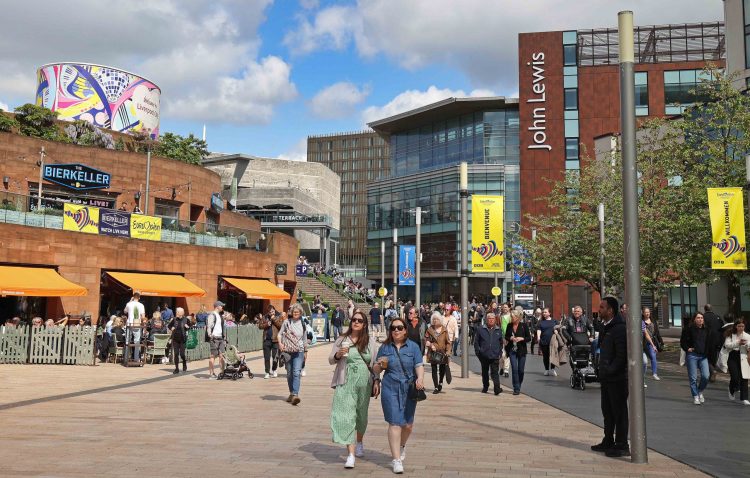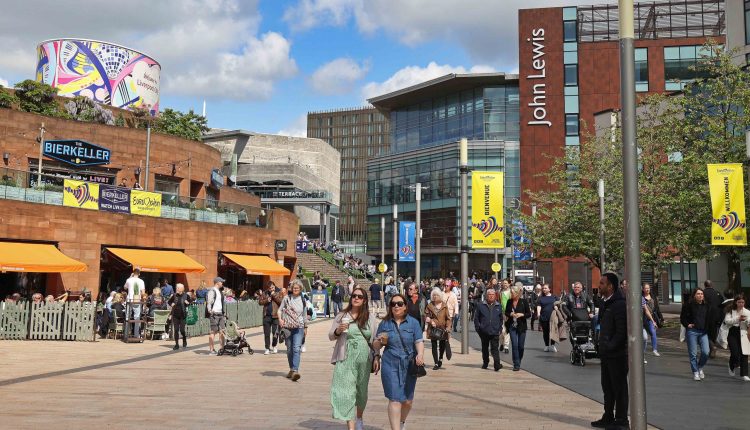Liverpool ONE releases report claiming it has generated £4.1bn in economic activity for the city since it opened in 2008 – but a legal challenge by one maverick developer almost scuppered the scheme. Tony McDonough reports

A new report shows the huge impact Liverpool ONE has had on the city since it opened at a cost of £1bn in 2008.
To mark its 15th anniversary, Liverpool ONE commissioned a report by Deloitte to assess the economic impact of the 42-acre retail and leisure complex on the city since its launch. It claims it has generated £4.1bn in economic activity during that 15 years.
This report also claims it has played a key role in the 24% of Liverpool’s visitor economy during that period. The sector in the city region saw a big dip during the pandemic but has since recovered strongly and is now worth more than £5bn a year.
Liverpool ONE opened in two stages – in May and September – in 2008 which was also the year Liverpool was European Capital of Culture.
Also opening for the first time that year was the ACC Liverpool arena and convention complex. Both developments have proven to be massive economic drivers for Liverpool city centre.
In early September Mark Preston, chief executive of Liverpool ONE owner Grosvenor, told LBN the property company took a huge financial hit on the project in 2008 due to the global financial crisis.
In 2013 the then chief executive of retailer John Lewis, Andy Street, spoke of how critical Liverpool ONE had been to Liverpool’s economy. The now Metro Mayor of the West Midlands said that without it, the city’s retail core was at risk of “market collapse”.
Other statistics in the report include:
- £1.9bn to the UK Exchequer and £300m in business rates.
- Hosting 390m visits.
- Supported an average of 4,700 jobs annually for Liverpool residents.
- Supported 500,000 local young people by funding community projects.
- Hosted 1,500 community events and around 12,000 charity collections.
Liverpool ONE was developed by Grosvenor in partnership with Liverpool City Council. And it was a project that hinged on the outcome of a court battle between the council and a local developer called Bill Davies.
Mr Davies, who died in 2016, was a controversial character in the city. In the late 1970s he had saved the Grand National from extinction only then to announce a massive hike in ticket prices.
His Walton Group later bought the prominent Exchange Flags office complex in the city centre and then left it empty for almost two decades, to the frustration of the city’s business and political leaders.
He also left the redevelopment of the former Post Office in Whitechapel half finished (the site is now the home of the Metquarter shopping mall). He later did exactly the same thing in the US city of Chicago.
But it was his £20,000 option on Chavasse Park, now the site of Liverpool ONE, that generated the biggest headlines. The council was keen to get out of the deal and strike and agreement with Grosvenor.
Mr Davies had his own plans to build an indoor retail complex. A High Court battle ensued. The council got their way but not before having to pay £2m to Mr Davies, who was by then a resident of the tax haven of Monaco.
Liverpool ONE’s opening reactivated the centre of the city, re-establishing Liverpool’s status as a pre-eminent retail destination, propelling the city from the UK’s 17th most popular retail destination to fifth.
In contrast to other indoor shopping complexes across the UK that have had a detrimental impact on retailers outside, Liverpool ONE was built as an open air scheme, incorporating existing streets and linking seamlessly with the rest of the city centre.
Today it works in harmony with Liverpool BID Company which oversees the management of the city’s retail and commercial district outside the Liverpool ONE boundaries.
According to the report, average spend per head has increased by 89%, sales increasing by 195% and the catchment area increasing by 77%, over the past 15 years.
In the last five years alone, Grosvenor has signed, renewed or regeared almost 70 brands. These include Inditex, Zara, Bershka, Pull&Bear and Stradivarius.
The destination is also home to the largest JD Sports in the world and the £10m Gravity MAX, which opened in the former flagship Debenhams department store.


It has also played an important role in the community, with the Liverpool ONE Foundation donating £3m to support young people and promote positive mental health and wellbeing.
Rachel Dickie, executive director of investment at Grosvenor, said: “While today marks 15 years of Liverpool ONE, Grosvenor’s commitment as developer and co-owner and manager of Liverpool ONE dates back nearly 25 years to its inception in 1999.
“From the outset, we were committed to creating a new city centre to an exceptional level of quality.
READ MORE: Global juice bar brand opens new Liverpool outlet
READ MORE: ‘Merseyside needs more devolution’ says Lord Heseltine
“This, combined with a focus on contemporary urban design, place shaping and sensitivity to local identity has underpinned Liverpool ONE’s attractiveness to occupiers and visitors for almost a generation.”
Leader of Liverpool City Council, Cllr Liam Robinson, described Liverpool ONE as a “phenomenal asset for our city”. He added: “Its design didn’t just reshape our city centre, it reimagined it.
“Its offer didn’t just reinvigorate our retail offer, it reinvented it. Its appeal didn’t just stay within the city, it reached out across the UK and beyond.”

